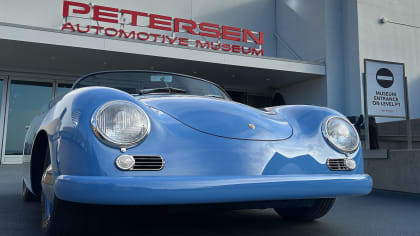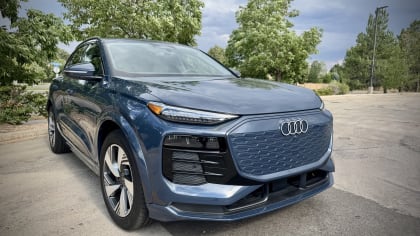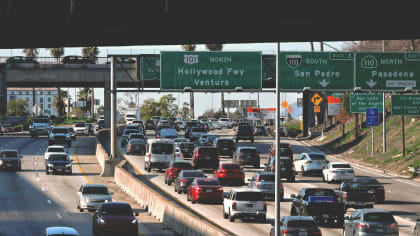NASCAR NOTEPAD: GOING IN CIRCLES A DAUNTING TASK
This article is from our archives and has not been updated and integrated with our "new" site yet... Even so, it's still awesome - so keep reading!
Published on Sat, Jan 29, 2011
By: The LACar Editorial Staff

LA Racing at Toyota Speedway in Irwindale
Words by Brian Kennedy
Pictures by Gabriela Moya
The Setup
Anyone who watches NASCAR on the weekends has probably said to him/herself, “These guys are crazy, but I think I can do that.” My response to that? Yes, they are. And no, you can’t. But you can get a little bit of the feel of it by taking the stock car driving school offered by LA Racing at Toyota Speedway in Irwindale.
What you’ll discover is that it’s a far more complicated, technical, and frightening thing to be strapped into one of those steel missiles than it looks. But you’ll also find that the people who run LA Racing at Toyota Speedway (a school which has been open for the past three and a half years) are experts at making your experience just frightening enough to be something you’ll be proud to say you did. The school offers a variety of driving experiences for people of all skill levels, from a 10-, 20- or 40-lap classes, to competition school. They also host corporate events for team-building or just to reward employees for work well done.
My class is the 20-lapper, and it starts with an introduction by Ozzie Blackwell, on-site manager of the school and all-around great guy. Then there is fire safety training, and then driving instruction from Doug Cummings and David Bremer, competition course instructors.
My class is a mixture of younger people and old, men and women. As I ask around afterwards, I discover that motivations for taking the class differ. One man owns a Corvette, and his wife wants him to have a chance to drive fast without risking tickets. One fellow got the class as a birthday present, and is brought to the Speedway blindfolded. Another is an adventurer-type, who had also recently tried indoor skydiving.
What they aren’t? NASCAR wanna-be’s, or even fans, I am surprised to find out. Most say they don’t watch that kind of racing on TV, and only one, the birthday boy, has been to Toyota Speedway before to see a race, and that was when he was much younger. So for all of us, the stock car driving experience is something new.

Instruction
In the school’s classroom, we learn how to control the car, the procedures for using the track, and what to expect from the experience. It’s clear from the start that this isn’t going to be an easy Saturday afternoon cruise. This is serious business at up to 125 mph. (At least, that’s what the cars would do. Most of us would probably top out around 105 and make laps at a speed averaging somewhere around 70-80. But it would feel a whole lot faster, as we were soon to find out.)
Instruction takes about forty-five minutes, including a thorough briefing on the track’s layout, as well as details about how to drive. The emphasis in the class is on how different driving a stock car would be from anything else we’d done. Ozzie summarizes the school’s message: “The key to today is communication.” We only realize how right he is when we’re cocooned in our cars, the earpiece our only way of knowing what we ought to do.
The lessons of the class all seem pretty simple and easy to follow. On the gas, off the gas, turn, be smooth. Doug passes on six key points, including what to do in a spin, and David reiterates and adds notes about technique.
With that, off my group goes to be outfitted in fire suits, helmets, and ear buds so we can take to the track. Three cars at a time go out.

Trackside
The waiting is excruciating. It’s not that you’re so anxious to go. More like you’re waiting for your chance to skydive, or standing in line for the monster roller coaster—you ask yourself why you ever thought this is a good idea in the first place. (Soon, you’ll find out how wrong you are—it’s an amazing time.)
The driving experience starts with getting into the car through the narrow window opening. Though I’ve never had an MRI, the feeling is a bit like being in one of those machines, I think. You settle in the seat, surrounded by metal and also foam-padded bars, a scant few gauges in front of you. Then they come along and strap you down. The five-point harness holds you so tight your shoulders are pressed down towards your hips.
When I gestured as much, my crewman said, “That’s OK, you won’t notice it once you get out there.”
Then I remember what Doug said: As we go into the car, we are to stretch out our arms and relax. “Breathe,” he told us. Impossible. “Relax in there, you’re going to feel some anxiety. You don’t do this every day.” And how!
The one message consistently reinforced by everyone from crew to teachers to Ozzie Blackwell is that driving is all about being smooth. “Roll on the throttle, roll off the throttle, like there’s a string connecting your hands on the wheel to your foot on the gas.” David showed us how this works in the class. “Roll off, turn. Roll on, unwind,” he repeated. “Smooth.”
At the time, we believed that when we got out on track, we’d remember this, even though he said that as soon as we were strapped in, everything from the class would go straight out the window net that was buckled into place to our left.

The Track
Th, master switch on.” I turn the big red switch to my right. “Ignition switch on.” I click the little silver toggle upwards with my left hand. “Ignition.”
They might as well have said what we did as kids, “Blast off!” As I pressed the button that starts the 350 cubic inch machine, I feel like I am under mortar fire.
Now, I’m no stranger to fast, loud cars. My personal machines are V8s (except the Nissan cube, but that’s a story for elsewhere at LACar.com), but isn’t so much an engine starting as a rocket exploding.
“Whump!” It goes as it fires, then “Rumpty rump” as I banged the super short-throw shifter into gear. I ease onto the gas, mindful that I ams on the access road. The car veers, directly toward the wall that separates me from the track.
Of course it does—that’s what it’s set up to do. Its whole purpose in life is to make a counter-clockwise circle. And they’d told us this in class—the tires are staggered so that the car naturally wants to go left.
“But why on this little access road?” I thought as I hear, “OK 32, take it easy, that’s a wall to your left” on my earphone.
“OK, OK,” I say to myself as I go down the chute. It’s actually a pretty long run you make until you’re on the back straight, down past turns one and two. I go through the gears as I move forward, slowly. By the time I’m in fourth, I’m about to go onto the track. To my left on the far side of the infield, I see the empty grandstand. On a race night, it might hold 6000 people.
“If only Jack Roush were up there . . . .” Actually, that’s the last thing I am thinking. What is in my head instead is, “Holy cow, this track looks a lot bigger from here!” The half-mile oval has progressive banking of 6, 9, and 12 degrees. But it’s way wider than it seems from the stands. The car in front of me looks tiny.
Then I wind through the third and fourth turns, which are narrower in radius than turns one and two, and I realize that at this speed, space disappears far more quickly than what I’m used to. This was going to demand a lot of concentration.
I head past the starter’s stand, the green lights flashing to tell me and my fellow drivers that we’re clear to go as fast as we feel is comfortable. Turns one and two are wide, and after a couple of laps, I’m not so shy about going into them with the gas on. This feels like I’m flying, though I know from watching the drivers who took to the track before I did that from the stands, things appear much more tame.
“Stay back of the car in front, 32” my earphone says, “You can’t pass until we say so anyway.” The school uses what they call “controlled passing” technique, which instructor Bremer describes as a dance.
“You go this way, down low, and you keep that line. I go that way, up higher, and take the pass. When I’m in front, you move back up. If we do it right, it’s like a dance,” he says as he shows the action on the classroom board, on which is a diagram of the track with the corners numbered.
Because they know that you can’t see anything behind you and that you’re not an expert, the instructors choreograph these passes by talking to you in your earphone. It’s the only way it would work, especially with the tunnel vision that sitting way down in the car generates. I don’t recall looking in my rearview mirror even once.
I move through turns one and two one more time, mindful of what they said in the class—as soon as you’re on track, you forget everything you’ve been told.
When I heard this, like probably everyone else, I told myself this would not happen to me. “I’m experienced, sort of,” I thought. “And anyway, it’s only a half-mile track, and I’ve driven lots of different cars in all kinds of conditions.” But being on track, it became clear how much information there is to process. I did not want to be the guy who put his ride into the wall.
Believe me, once you get out there, the noise, the buzz in the ear, and the disorientation of the unfamiliarity of the car makes it impossible to hear, see, feel, or do anything except watch the line, steer, and control the throttle. And even those sensations come through a bit of a mist, your fingers numbed by racing gloves and your feet far away beneath you on a set of pedals which feel nothing like those in a street car.
After about ten laps, you start to feel it a little. The panic subsides, and you realize that you can stay on the gas a little bit longer than you have been. Instead of getting off before the corner, you wait until you get to the line painted on the track which signals the start of the corner. Then as you get to the apex, also marked, you mash the gas again, rather than waiting until you’re once again headed down the straight. You carry a little speed into the corner.
And you realize you’ve made your best lap. So you get brave, and try to drift up a bit to a higher line. Or at least, I did.
“OK, 32, back on the line. You’re kind of high,” I hear just as the feel of the back end sliding ever-so-slightly caught up with me. I get back on the line and powered out of the turn down the back straight.
By about lap 15, you’re tiring. Hard to believe considering that the laps are somewhere short of thirty seconds, but my back is hurting. This is probably more from tension than from fighting the car. The steering wheel is relatively small, and it doesn’t take a lot to make the car turn left, as was mentioned. But the whole experience is one of heightened emotion and sensation, and it invades your entire body.
As I am going down the back stretch for the fourteenth or fifteenth time, I glance at the grandstands and think, “Why do guys want to race all weekend as a hobby?” This, I realize, is not about mashing the gas, or getting away with something that you can’t do on the street. This is science and art combined into one, and at the level of even the serious hobbiest, every lap has to be dissected, and the difference between winning and coming thirtieth would be, likely, minute.
I am starting to feel like I’d had my fill, but then I hear, “Five laps to go” in my ear, and I tried to make them my best.
The instructors tell you before you start, “There’s no one in the grandstands waiting to offer you a contract,” to discourage the wanna-be’s from getting out of control. After all, it’s a 2500-pound car with 450-500 horsepower, and you’re only flesh and blood, as are your classmates. They encourage you to test yourself, but with control, and they are monitoring everything and keeping you on task by talking in your ear.
It ends all too soon, and I am quite sad as it is time to pull into the pits again. Then the feeling of the enormity of it all set in , and I can’t find the brake as I come in at the end of my session. I felt for it with my right foot as I’d been told to do, and as I had practiced in the car before the run (per Doug’s instruction), and still I felt nothing. I had to look down around the steering wheel to my feet to locate it. Nobody is any the wiser, and I bring my Intel-sponsored car to a stop and shut it down.
Reflecting on the experience as I take off my firesuit, I think that if I can just sit down and think about things a while, I can start out the next session where I had left off in this one. I could process my best lap and figure out where I’d gone wrong on my worst ones, and do better. I would start out without the grip of claustrophobia which I had felt the first time in the car. I was hungry for more, as you will be if you take one of these classes.
Which is why I’m glad that Ozzie asked me back to do it again.
I’ll report in again in a few months, when I’ve had time to process this experience, think through the excellent lessons my teachers Doug and Dave offered, and go out and complete another school.
If what I overheard from my classmates is right, most of them will be doing the same thing. Ozzie says in his introduction to class that students end with a huge grin. He’s right, and it’s universal, not only for the drivers, but for the friends and family who watch.
Right after each session, students are mobbed by those who came with them, wanting to know what it’s like. Here are some overheard snippets (which I was given permission to reproduce):
“You can tell that the car is saying, ‘Come on, let me give you the ride of your life’.”
“Now I’d like another twenty [laps].”
“I’m already planning my third and fourth trips back here!”
“Everything, from the start-up, was awesome. I felt like I was going to take off to the moon. I kept on it, and I felt like I was getting a little bit faster each lap.”
The last is from Tom who of all of us, is the one who seems like he really has some talent. He really did take the pro line, and seemed to move the car around rather than take a flat line like most of the rest of the class did. His mom says he’d been wanting to do this all his life, and while he confesses having no interest in NASCAR racing, there is a gleam in his eye which suggested that this might only be the start for him.

The Summary
Driving a stock car is frightening. But I want to do it again, and so does everyone who took the school with me.
The Pros
Great staff, from the person who greets you to the instructors to the woman who puts on your helmet.
Fun experience in the car, though it’s nothing like you think it will be.
The Cons
None—except that you’ll want to go back again, so save your pennies!
For information, go to LARacingX.com or call 877-901-RACE

SIDEBAR
The Shoe
Every school needs a guest expert, and at LA Racing, that person is Ryan Partridge. He’s a youngster at twenty-two, but already a track record holder at Irwindale running Super Late Models and Super Trucks. Last season, he notched ten victories in a row at the track.
At LA Racing, Ryan is part of the teaching team, with one key role—to take people for ride-alongs in one of the Super Late Model NASCAR cars. Watching him do it after my class had run, I could see that his line was way different from ours, up close to the wall in the corners, and I could just imagine the sheer terror of the person in the passenger seat. I also wanted desperately to be that person, to watch up-close how Partridge worked his magic. He says about his role at the school, “I see that this place makes a lot of people happy, and that makes me happy. To watch the smile on people’s faces and the kick they get out of it, that makes me appreciate racing a little bit more.”
In addition to the string of victories already cited, he also holds the track record for lap times in both the divisions he runs, though he doesn’t remember the times specifically when asked. “I’ve run so many laps here, you lose track of that stuff,” he says casually about the feat.
His goal is to move up in the NASCAR world, but he knows that the business he’s in is a hit-or-miss affair, that landing the right ride to move to the really big time is a matter of tapping the right person on the shoulder at the right moment, but he’s got all the skills. He’s personable, just talkative enough to be someone who would represent a sponsor well, and photogenic.
He also knows a lot about what he drives, and he works on his cars as well as driving them. “I’ve been doing this since I was four and a half years old. I had thousands of laps before I had a driver’s license, so it’s second nature to me. I know what the car is thinking; I know what it’s going to be thinking,” he says with conviction.
When he comes into the pits, he describes exactly the changes he wants to his crew. “I am the crew chief and the driver. I come off the track with five specific things we need to do to the car. We need a round in the right rear, we need to raise the rear roll center a half inch . . . . I’ve been doing this my whole life, and I’ve been hands-on with all my cars. I know what changes respond in what way. We come to one solution that is the right solution. There are a hundred different changes that could be made, but one is always the right one. As a driver, I can tell what the car wants.”
“We’ve done very well in both divisions, because, I think, of my level of dedication. I have two paid-for rides. That’s what it takes these days. I couldn’t do this on my own. I’m just a broke kid.” He works a full-time job in addition to spending his evenings at the two race shops which house his rides.
In describing his career goals, he says, “My ultimate goal would be NASCAR, and I feel like I’ve been ready as a driver now for a few years. It’s a matter of reaching that maturity level to where I’m marketable. You meet the right people, and it happens.”
He’ll be racing at the Toyota All-Star Showdown in late January, an event which gives him an audience which just might include someone who could offer him a break to the next level, and he’s aware of the chance. “I know as a driver I’m capable; I know the equipment we’re in very well. I’ll be trying to keep all of our variables under control, and impress who I need to impress. I know as a crew we’re capable, too. Getting the combo to work in synch is what will make it happen.”
For this young man, maybe the big break will be soon. The NASCAR ladder would next take him to the West touring series, then the Nationwide series, then Cup, though he points out that a driver doesn’t necessarily have to go up the ladder by taking every step. “You just have to have the right people notice you.”
If you meet Partridge, you’ll probably agree that you wish him nothing but the best. And if you are one of those “right people,” then stop reading and go over to ryanpartridge.com to offer him your help, especially if your first name is Jack and your last name is Roush.





